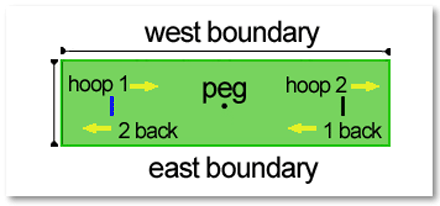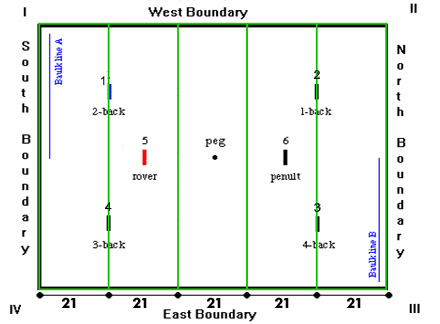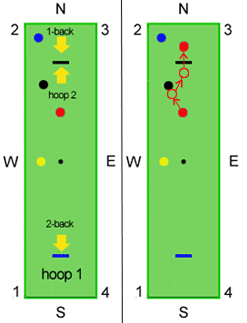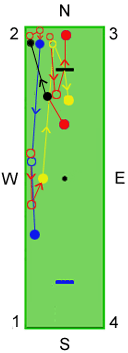
|
Back to |
| The Front Page |
| The Game |
|
With Compact Croquet, everyone can play at the same time |
||||||||||
|
by Bob Alman with thanks to Louis Nel, who developed and has used similar rules for many years in Canada Posted August 20, 2012
|
||||||||||
|
||||||||||
Most croquet clubs in the world have many more members than can be accommodated in play simultaneously on all the lawns of the club, in double-banked doubles. A standard "full capacity" formula for clubs calls for a maximum of 25 players for each club court, but no more than eight players can play on each court in normal circumstances. So how can the club have "social" days that include play for everyone at the same time? And how can the club accommodate large novice groups for training or revenue? The answer to both questions is: Compact Croquet.
Louis Nel produced an article on this subject for the old website of the Ottowa Croquet Club and has used the reduced courts and rules proposed in this article many times, for both advanced players and novice groups. He comments, "Novice players have no problem at all with the reduced club configuration, because the order of the course actually makes more sense to them that the conventional arrangement; only club members would consider them unusual."
I made the same discovery in San Francisco, as manager of our corporate groups there, but the only Compact Courts I ever designed and used were for Golf Croquet.
Compact Croquet--whether for Golf Croquet, Association Croquet, or American Rules, is played on a narrow court with one hoop at each end and a peg in the middle. Hoops 1, 2, 1-back, and 2-back are contested by both balls, followed by the peg, thus allowing a maximum score of 10 points in Association Croquet.
Compact Association Croquet challenges
players at every level
The different flavor of the Compact Association Croquet comes just as much from its space-efficient configuration as from two modifications in the laws: When a hoop is run, the turn ends abruptly with that stroke; no continuation stroke is earned for scoring that hoop. Secondly, a hoop cannot be run unless the player has made a roquet on an opponent ball earlier in that turn.
These modifications have a profound effect--especially for advanced players. (Again, novices won't be aware of anything unusual about it.) The first rule guarantees short turns and a highly interactive game at all levels of expertise. The second modification forces novices to think beyond partner ball and to use the rush stroke as an important tool. If you intend to score a hoop, you need to think carefully about where that ball will be after the hoop stroke and whether it's going to be vulnerable to the opponent's roquet.
A continuation shot after running a hoop is an essential ingredient for any version of Association Croquet aimed at break play. Since Compact Croquet aims deliberately to avoid break play, there is no need for a post-hoop continuation shot. In fact, such a shot would just open the door for leaves that could keep the hoop runner in control and cause the game to be less interactive. As in Golf Croquet shows, the player of the next turn (after the opponent scores the hoop) can to start off with a good chance to score or to make some other play that advances his game.
The court size and all elements of the game, potentially including bisques for both players, could be arranged to allow the winner in a novice game to finish at the peg within an hour. For advanced players the game will normally last between 40 and 50 minutes. Advanced players can enjoy solving the problem of creating reasonable leaves under the challenging circumstances of abruptly ending turns; also they will be attracted by the lure of playing “bumper” turns (in which a point is scored for both partner ball and striker ball-- a triple peel counter part).
For beginning and intermediate players, Compact Association Croquet is a fun way to cultivate basic shot-making skills--especially precision rushes.
LAWS FOR COMPACT CROQUET
1. The Laws of Association Croquet (Ordinary Singles) apply where relevant, except where modified in the laws to follow.
2. Court Set-up

|
| Compact courts for Golf Croquet and Association Croquet are the same--for only two hoops and a peg--with one exception: The hoop direction for Golf Croquet calls for simply repeating hoops one and two in the same direction, while in Association Croquet, Hoop #2 immediately after scoring become #1-back. |

|
| It's easy to divide a full-size court into five equal courts. Start by setting the boundaries on each of the long ends across the setting for the corner hoops. Then create the three more Compact Courts in the center by stringing off two more boundary lines at 21-foot intervals. |
The standard Compact Croquet court is rectangular and measures 9 x 35 yards. Smaller courts may be used, and are preferable for beginners. One ordinary 28 x 35 yard court can be subdivided into
3 full compact courts of 9 x 35 yards
5 smaller compact courts of 7 x 28 yards
The peg is placed at the center of the court. There are only two hoops set equidistant from the long boundary lines and one fifth of the court length from a short boundary, on opposite sides of the peg. Hoop 1 has a colored crown to provide orientation.
For purposes of laws application, the short boundary line nearest to Hoop 1 is called the South Boundary and the other three are called West, North, East in accordance with the usual orientation. The line segment from the corner 1 spot to the midpoint of the South boundary is Baulk Line A. Diametrically opposite at the other end one finds Baulk Line B.
3. How points are scored.
(3a) Hoops are to be scored in the order: 1, 2, 1-back (i.e. Hoop 2 reversed), 2-back (i.e. Hoop 1 reversed). Hoop 2-back is the Rover Hoop and a ball that has scored it is a Rover and is entitled to score a Peg Point and to peg out another Rover. Clips are placed on top of Hoop 1 and Hoop 2 and on the side of Hoop 1-back and Hoop 2-back.
(3b) A ball scores a hoop point for itself when it runs its hoop in order subject to the restriction that a hoop can be run only after a roquet has been made on an opponent ball earlier in that turn. This restriction on hoop running does not apply after some ball has been pegged out. Nothing in this law precludes a ball from scoring a hoop point by being peeled through its hoop by its partner ball or by an opponent ball.
4. Turn ends after hoop point. If a ball scores a hoop point for itself, then the turn ends with that stroke. (So after a hoop has been run there is no continuation stroke and if a ball is hit in that stroke, it is not a roquet). Nothing in this law precludes a player from continuing after peeling another ball without scoring a point for the striker's ball.
5. Winning the game. The side who is first to score all 10 possible points (4 hoop points and one peg point for each ball) wins the game. Time limited games are possible and are covered in the general laws.
6. Handicap play When a bisque turn ends it is the opponent's turn to play. (i.e. one bisque turn cannot immediately follow another).
Optional rule:
How to challenge "Aunt Emma"
Without a special rule, a player once ahead could sit on a lead by setting a defensive leave after each turn, instead of playing the free-wheeling game we're aiming for. To avoid that, player who has made a roquet is compelled (in this optional rule) to make at least one scoring attempt during his turn; otherwise the opponent gets a baulk line lift. For the purposes of this rule, a scoring attempt could be either an attempt at a peel or at a hoop point from a potential scoring position.
It is a serious shortcoming in the old version that it does not call attention to how frequently a player could try to score. It is very difficult to set really good leaves that prevent a player from hitting in. So the game is highly interactive.
I believe this is a good nursery game to prepare for both American Rules and Association Croquet, because it gives good practice in croquet strokes and rushes with no high risk. In conventional Association Croquet, you often see beginners retreat to their corner without really attempting anything. Here such behavior will put the player at a serious disadvantage. And if he fails, the worse is usually just a single point for the opponent. And in American Croquet the fear of deadness inhibits players terribly. Using this "Aunt Emma" rule, the scoring attempt is the order of the day.
A sensible alternative to double banking
Novice players are especially easy to distract with double banking. While the number of players on a court becomes doubled with double banking, it becomes trebled with Compact Croquet even when all games remain single banked.
For example, when one 28 x 35 yard court is subdivided into three compact courts of 9 x 35 yards, three simultaneous single banked singles games can be played, using the available real estate much more efficiently.
If you divide one full-size court into five compact courts, you'll have space for 20 people in simultaneous play without double-banking.
Compact Golf Croquet
Golf Croquet works especially well on a Compact Croquet court, using the peg as the "halfway point." The hoops are simply run in the order 1,2,1,2,1,2,1… and so on until the required number of hoops have been scored. Use one rule modification to account for the rare instance in which two hoops are scored in one stroke: If Hoop 2 becomes scored while some balls have not moved from where they came to rest while contesting Hoop 1, then those balls must take their next shot from a spot within one yard of Hoop 2. (For novice tournaments under pressure of time, a "first to five points" rule would be workable.)
|
A STRATEGIC SITUATION FROM LOUIS NEL
In preparing for this article, I played a game against myself on a 21' by 84' compact court, and the following situation arose. It demonstrates the strategic richness of these Compact Croquet Rules for Association Croquet.
Red: 4 yards south of hoop 2, for hoop 2 Black 4' NNW of Red, for 1-back Yellow: 2 yards west of peg, for 1-back. It is Red to play. Look at the options. For a beginner, the obvious choice is to roquet Black and try to run #2 off Black. The more advanced player won't like this option, because after running the hoop, Blue will have a feast; Blue could roquet Red, get behind Black while sending Red far south, rush Black to peel position north of #2, peel it while getting to hoop position, run the hoop, thus scoring two points and ending the turn with a half-decent leave.
Red rushes Black past Blue, gets a good rush on Blue toward Yellow, rushes Blue to Yellow, splits pass it getting a good rush on Yellow to its hoop, and rushes Yellow to north of the hoop, in the hope of peeling it while getting to hoop position, then (if all goes well) scores the hoop, with a prospect of scoring the extra peeling point. - Louis Nel |

